Download
Download this file as Jupyter notebook: rc_simple_intro.ipynb.
Example: Running Randomized Compiling
This example provides a short demonstration of True-Q™’s
randomly_compile() function and how it can be used to generate a set
of randomly compiled circuits from a single input circuit, while implementing the same
unitary as the original circuit. For more background information, check out our
Randomized Compiling (RC) user guide page.
Note
Randomized compiling produces a new circuit collection after each call, so the output of this example will be different if it’s executed again.
Generating randomly compiled circuits
We begin by creating a simple two-qubit circuit with alternating cycles:
[2]:
import numpy as np
import trueq as tq
cycle1 = {0: tq.Gate.h}
cycle2 = {(0, 1): tq.Gate.cz}
cycle3 = {1: tq.Gate.h}
circuit = tq.Circuit([cycle1, cycle2, cycle3] * 3)
circuit.measure_all()
circuit.draw()
[2]:
This circuit produces an equal superposition state of all four possible two-qubit
states, as a quick simulation with our built-in Simulator shows:
[3]:
sim = tq.Simulator()
ideal_result = sim.sample(circuit, n_shots=np.inf)
ideal_result.plot()
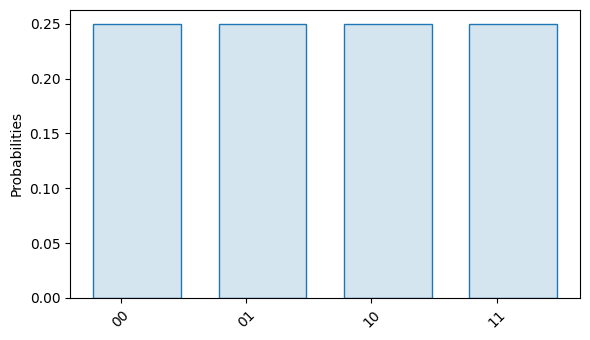
We can also inspect the operator that this circuit is implementing:
[4]:
circuit_operator = sim.operator(circuit).mat()
tq.math.Superop(circuit_operator).plot_rowstack()
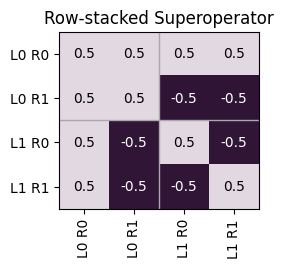
To generate a set of randomly compiled versions of this circuit, we call the
randomly_compile() function and pass our circuit as argument,
together with the desired number of compilations:
[5]:
n_compilations = 30
rc_circuits = tq.randomly_compile(circuit, n_compilations=n_compilations)
This function returns a CircuitCollection of 30 randomized versions
of our original circuit. For example, the first circuit in this collection looks like
this:
[6]:
rc_circuits[0].draw()
[6]:
We can verify that this circuit (as well as every other circuit in this collection) implements the same operation (up to a global phase) as our original circuit by again inspecting the circuit operator:
[7]:
rc_circuit_operator = sim.operator(rc_circuits[0]).mat()
tq.math.Superop(rc_circuit_operator).plot_rowstack()
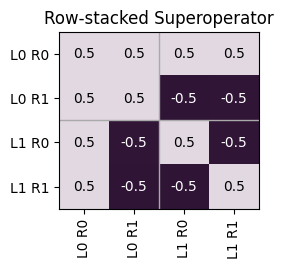
For a phase-insensitive comparison, we can calculate the process infidelity between
these two operators. The process infidelity is a metric for how different two
operations are; an infidelity of zero means they are equivalent up to a phase. We can
use the built-in proc_infidelity() function for this:
[8]:
tq.math.proc_infidelity(circuit_operator, rc_circuit_operator)
[8]:
-8.881784197001252e-16
Finally, when we sample from the final state’s probability distribution every circuit yields the same result:
[9]:
for rc_circuit in rc_circuits:
assert tq.utils.dicts_close(sim.sample(rc_circuit, n_shots=np.inf), ideal_result)
Measuring RC performance
To test how well Randomized Compiling works in practice, let’s walk through a short simulation of the circuit above with a noisy simulator and look at how the RC circuits perform relative to the bare circuit.
First, we create a simulator with an overrotation error as the noise source and simulate the outcomes of the bare circuit under this noise model:
[10]:
noisy_sim = tq.Simulator().add_overrotation(single_sys=0.1, multi_sys=0.1)
noisy_result = noisy_sim.sample(circuit, n_shots=np.inf)
noisy_result.plot()
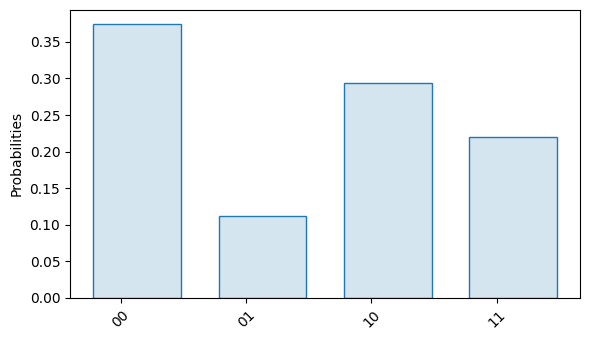
Note that we are no longer seeing the equal superposition that the noise-free simulation produced.
Next, we simulate the randomly compiled circuits under the same noise model, and sum the outcomes over all circuits:
[11]:
# run all circuits on the simulator
noisy_sim.run(rc_circuits, n_shots=np.inf)
# sum over the outcomes
rc_result = rc_circuits.sum_results()
# for plotting, we normalize the summed results to be between 0 and 1
rc_result.normalized().plot()
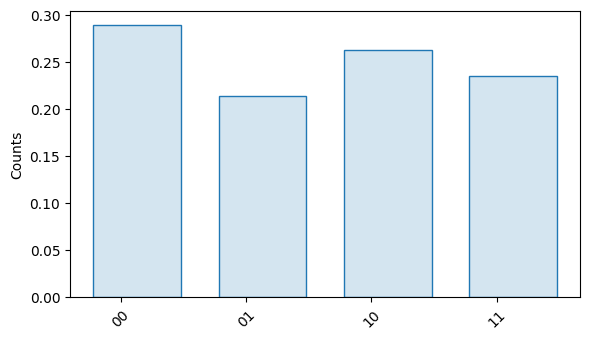
Under Randomized Compiling, the noisy simulation produces a result that is much
closer to the noise-free simulation. In fact, we can use the
trueq.Results.tvd() method of the Results class to
quantify this difference:
[12]:
bare_tvd = noisy_result.tvd(ideal_result)
rc_tvd = rc_result.normalized().tvd(ideal_result)
print("Noisy simulation without RC: {:.4f}".format(bare_tvd[0]))
print("Noisy simulation with RC: {:.4f}".format(rc_tvd[0]))
Noisy simulation without RC: 0.1686
Noisy simulation with RC: inf
Warning: divide by zero encountered in divide
(/home/jenkins/workspace/release trueq/trueq/results.py:489)
The TVD, or Total Variation Distance is a measure for how far two probability distributions are apart. A value of zero means the distributions are equivalent.
Finally, we can produce a visual summary of these results:
[13]:
tq.visualization.plot_results(
ideal_result,
noisy_result,
rc_result,
labels=["Ideal Outcome", "Without RC", "With RC"],
)
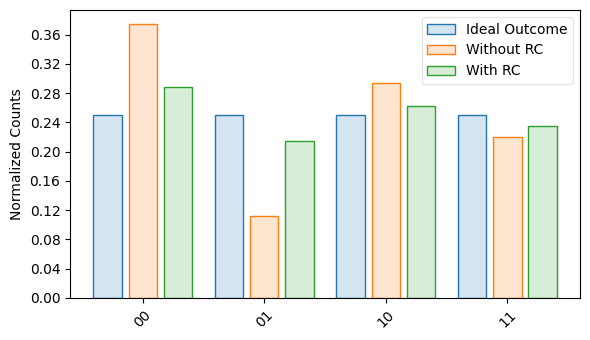
Randomized Compiling with Qudits
Randomized compiling works for higher-dimensional qudits in the same way as for qubits. The random gates which are added around hard cycles are drawn uniformly from the \(d\)-dimensional Weyl-Heisenberg group, and the original circuit must be expressed in terms of gates belonging to the \(d\)-dimensional Clifford group, that is the group which preserves the \(d\)-dimensional Weyl-Heisenberg group (see Advanced Qudit Framework for more information).
Let’s start by defining a simple circuit following the qubit example above but for qutrits:
[14]:
tq.settings.set_dim(3)
cycle1 = {0: tq.Gate.f3}
cycle2 = {(0, 1): tq.Gate.cz3}
cycle3 = {1: tq.Gate.f3}
circuit = tq.Circuit([cycle1, cycle2, cycle3] * 3)
circuit.measure_all()
circuit.draw()
[14]:
Generate a set of randomly compiled versions of this circuit:
[15]:
n_compilations = 30
rc_circuits = tq.randomly_compile(circuit, n_compilations=n_compilations)
# show a sample circuit
rc_circuits[0].draw()
[15]:
As before, let’s run this circuit on an ideal simulator to get the expected results, and then compare the impact of noise on the bare circuit to the randomly compiled circuits:
[16]:
ideal_sim = tq.Simulator()
ideal_result = ideal_sim.sample(circuit, n_shots=np.inf)
noisy_sim = tq.Simulator().add_overrotation(single_sys=0.1, multi_sys=0.2)
noisy_result = noisy_sim.sample(circuit, n_shots=np.inf)
noisy_sim.run(rc_circuits, n_shots=np.inf)
rc_result = rc_circuits.sum_results().normalized()
Plot the results:
[17]:
tq.visualization.plot_results(
ideal_result,
noisy_result,
rc_result,
labels=["Ideal Outcome", "Without RC", "With RC"],
)
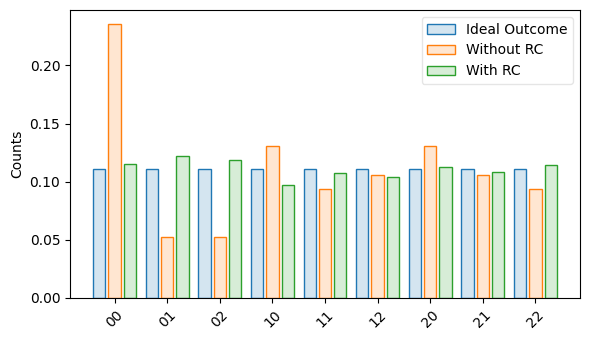
Download
Download this file as Jupyter notebook: rc_simple_intro.ipynb.
